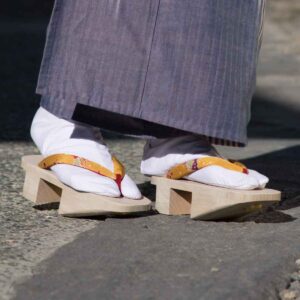While footwear held on by a thong is also seen in other countries such as Southeast Asia and Egypt, the distinguishing characteristic of traditional Japanese footwear is that it has no “left” or “right.” When trying to create footwear that fits the feet well, it’s natural to make a difference between the left and right sides. Surely the skilled craftsmen of Japan are capable of doing so too, yet this lack of left and right continues to this day. Why is there no difference between left and right in the long history of Japanese footwear? The Japanese concept of footwear differs greatly from a shoe or a sandal. Inside their houses, Japanese people are practically always barefoot, and walking or sitting on clean floors or tatami mats. Of course, if possible, they would prefer to walk barefoot outside as well. Ultimately, shoes and sandals are designed to be part of the foot. The idea behind Japanese footwear, however, is closer to a miniature portable floor or tatami mat under one’s feet. While there are left and right feet and thus matching shoes, there are no such distinctions for floors or mats. Indeed, this Japanese desire for barefoot living is what makes such footwear so good for one’s health.
Traditional Japanese Footwear Shop





